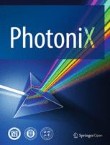Prof. Min Gu,who serves as the Editor-in-Chief of PhotoniX has been awarded the 2022 Emmett Norman Leith Medal of the Optica (formerly OSA) in the field of optical information processing. Min Gu serves as the Executive Chancellor of the University Council of University of Shanghai for Science and Technology (USST).
This Optica Medal, established in 2006, honours Emmett N. Leith, a world-renowned scientist in holography (the subject of the 1971 Nobel Prize in Physics) and optical information processing. It recognizes seminal contributions to the field of optical information processing.
Prof. Gu has been recognized for outstanding contributions to nanoscale optical information technology by extending the limit of optical data storage, holography and display through multi-dimensional division including optical orbital angular momentum and vectorial domains.
Prof. Gu is also a winner of the 2019 Dennis Gabor Award in Diffractive Optics of the International Society for Optics and Photonics (SPIE).
Prof. Min Gu is the awardee of Chang Jiang Chair Professorship and Einstein Professorship from the Chinese Academy of Sciences. Gu was awarded the Laureate Fellow of the Australian Research Council. He is a recipient of the W. H. Steel Prize (Australian Optical Society), the Ian Wark Medal and Lecture (Australian Academy of Science), the Boas Medal (Australian Institute of Physics), and the Victoria Prize for Science and Innovation. He was a Finalist of the Australian Innovation Competition and a winner of the People’s Choice KCA Research Commercialisation Award. Prof. Gu is a world leading authority in the fields of nanophotonics, nanofabrication and biophotonics with internationally renowned expertise in three-dimensional optical imaging theory. His research has led to significant impacts on societal challenges in information technology and big data storage and renewable energy.
Prof. Min Gu is the Editor-in-Chief of the Journal PhotoniX, which aims to present brave endeavors in promoting X-disciplinary research, latest progress of engineering applications and breakthroughs in scientific discoveries, all enabled by photonics. Original scientific letters, articles, reviews, and technology progress reports are equally welcome.
